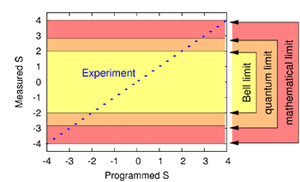Highlights
How a quintessential quantum test was fooled: paper in Physical Review Letters
When it comes to pitting quantum theory against classical notions of the world, there's one experiment that physicists say can make a clear distinction: a test of Bell's inequalities. But in newly-published work, CQT researchers and their collaborators from Norway describe how they faked quantum results using classical physics in such a test, reminding scientists to be cautious about the assumptions in their experiments.
Bell inequalities measure the strength of correlations between two particles, or how much their behaviours are coordinated. Classical correlations must obey Bell inequalities but, since quantum physics allows stronger correlations than classical physics, quantum correlations can violate them. In the experiment at CQT, a typical apparatus for measuring Bell violations by pairs of photons was cheated using bright pulses of light to manipulate the output of single-photon detectors. The researchers had previously used a similar trick to eavesdrop on quantum key distribution.

The 'faked' results: Bell experiments measure a parameter S, which in principle describes the strength of correlations between two particles. Classical correlations have S no more than 2 (yellow zone). The researchers were able to manipulate their Bell experiment for photons to output any value of S — tricking the apparatus into seeing quantum correlations (orange zone) when there were none. They could even fake correlations going beyond what quantum physics allows (red zone).
The new research, published 20 October in Physical Review Letters, was done by Christian Kurtsiefer and Valerio Scarani, CQT Principal Investigators and NUS Professors, along with former CQT members Antía Lamas-Linares and Ilja Gerhardt, in collaboration with Vadim Makarov, Qin Liu and Johannes Skaar of the Norwegian University of Science and Technology in Trondheim, Norway. The paper is highlighted by the journal as an "Editors' Suggestion" and has been written about in Physics, Physics Today, PhysOrg and Nature.
Researchers thinking ahead to quantum devices for communication and computation have proposed incorporating tests of Bell inequalities in such devices to act as safeguards. This work highlights the practical challenges of such schemes. It also reminds us that no Bell tests so far have been without seemingly reasonable ‘fine print' assumptions about how the experiments worked.
Measurements of Bell violations matching quantum predictions are considered strong evidence in support of quantum theory, and the first Bell tests went into physics history books. But all such experiments so far have had "loopholes".
To fake the results in their photon system, the CQT and Norwegian researchers exploited the so-called "detection loophole". Inefficiencies in the single photon detectors and other losses mean that typically less than 50% of photons detected can be matched into pairs because either one or the other of the original pair went missing. To fix this problem, one usually makes the "fair sampling" assumption: one assumes that the photon pairs detected are representative of all the photon pairs produced. But this may not always be justified — and in a cryptography scenario, this assumption can't be made because one needs to be wary of the possibility that a hacker has interfered with the photons.
The researchers tried to mimic single-photon signals in their apparatus by manipulating the detectors with bright pulses of light. However, changes to detector settings (in a Bell test, certain settings are chosen at random before each measurement) sometimes meant that their pulses and the detector settings were mismatched. In these cases, the detector would register nothing. The missing signals could have raised suspicions — but only if the apparatus overall were more efficient, so that the experimenter could spot the problem as worse than the usual photon losses.
In this attack, the researchers maliciously manipulated the results. We have no reason to think the Universe conspired to trick past experiments, but since past tests had loopholes, the conclusions have fine-print. Some Bell tests have been performed that close the "detection loophole" but there is a second common loophole, known as the "locality loophole", and so far no experiment has closed both at once. Various experimental groups worldwide, including the quantum optics team at CQT, are working towards this goal.
For more details, see the paper "Experimentally faking the violation of Bell's inequalities", Phys. Rev. Lett. 107, 170404 (2011); arXiv:1106.3224.
Coverage in the media:
- Physics: Eve fools Alice and Bob
- Physics Today: Physics Update: Faking Entanglement
- PhysOrg: Fake violations of Bell tests reinforce importance of closing loopholes
- Nature: Lasers illuminate quantum security loophole






